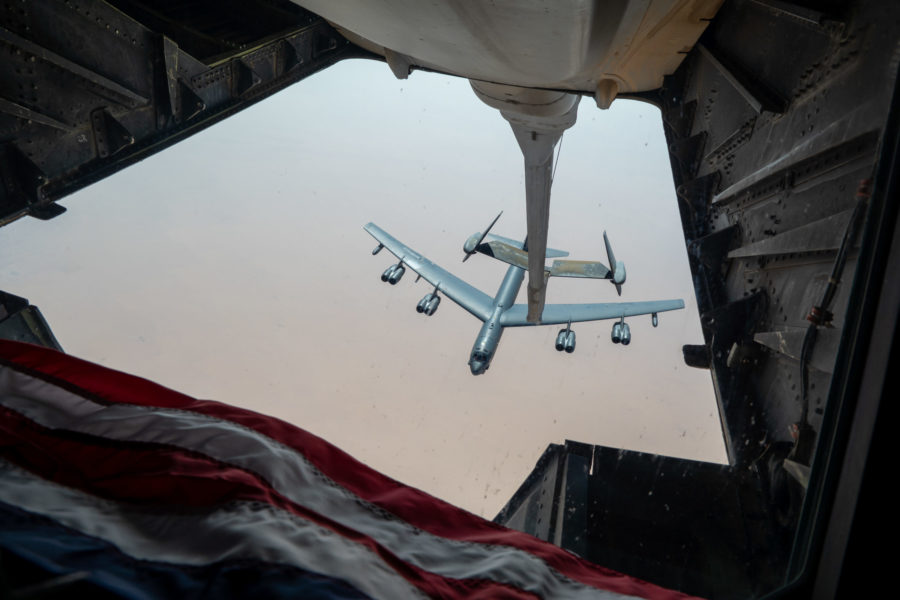A pair of B-52s flew over the Middle East on Sept. 4 as part of a bomber task force mission, integrating and training with partner nations and other U.S. aircraft along the way.
The B-52s, from the 5th Bomb Wing at Minot Air Force Base, N.D., took off from RAF Fairford, U.K., where they are deployed, for their bomber task force mission and flew over the Eastern Mediterranean, Arabian Peninsula, and Red Sea, according to a press release by Air Forces Central.
Along the way, the bombers linked up with fighters, tankers, and other aircraft from the U.S., U.K., Kuwait, and Saudi Arabia, including the F-15, F/A-18, RC-135, E-3, KC-135, KC-10, KC-46, FGR-4, and A-330.
“This Bomber Task Force is a strong, clear representation of enduring U.S. commitment to the region,” Lt. Gen. Alexus G. Grynkewich, AFCENT commander, said in a statement. “In addition to maintaining a sufficient, sustainable force posture, AFCENT is able—in concert with our partners—to rapidly inject overwhelming combat power into the region on demand. Threats to the U.S. and our partners will not go unanswered. Missions like this BTF showcase our ability to combine forces to deter and, if necessary, defeat our adversaries.”
In addition to the U.K., Kuwait, and Saudi Arabia, senior national representatives from 16 coalition nations provided enhanced logistical support for the BTF mission, and units from Army Central provided simulated firepower from the ground, the AFCENT release stated.
“This kind of operation demonstrates the collective capabilities of the military partnership we’ve developed in the Middle East,” Army Gen. Michael “Erik” Kurilla, head of U.S. Central Command, said in a statement. “We have the ability to put a significant measure of combat power in the air alongside our partners very quickly. We can do the same on the ground and at sea.”
Also joining the B-52s were three F-16s from the Israeli Air Force, which escorted the B-52s through Israel’s airspace, according to a statement from the IAF. The AFCENT release, however, made no mention of Israel’s involvement.
This marks the fourth bomber task force mission in the Middle East in 2022. All four have involved the B-52—two flew with KC-10s and KC-135s during a presence patrol in June; one flew with F-22s and aircraft from nine other nations in March; and one flew with Marine Corps F/A-18s in February.
It also marks yet another public display of solidarity and force on this latest deployment—the B-52s previously integrated with fighters from Norway and Sweden while flying to Europe and later flew over four NATO allies in southeastern Europe.
However, this latest mission comes just a few weeks after an exchange of attacks between the U.S. and Iran-affiliated militants in northeastern Syria; and as the U.S. and Iran continue to negotiate a deal to revive the Joint Comprehensive Plan of Action, an agreement meant to limit Iran’s ability to produce a nuclear weapon and lift U.S. sanctions.
President Donald J. Trump withdrew from the deal in 2018, and since then, Iran has enriched uranium to levels consistent with the construction of a nuclear weapon. Iran provided a written response Sept. 2 to a U.S. proposal that the State Department described as “not productive.” At the same time, Israeli officials have been advocating for the U.S. not to reenter the deal or not to agree to new concessions.






